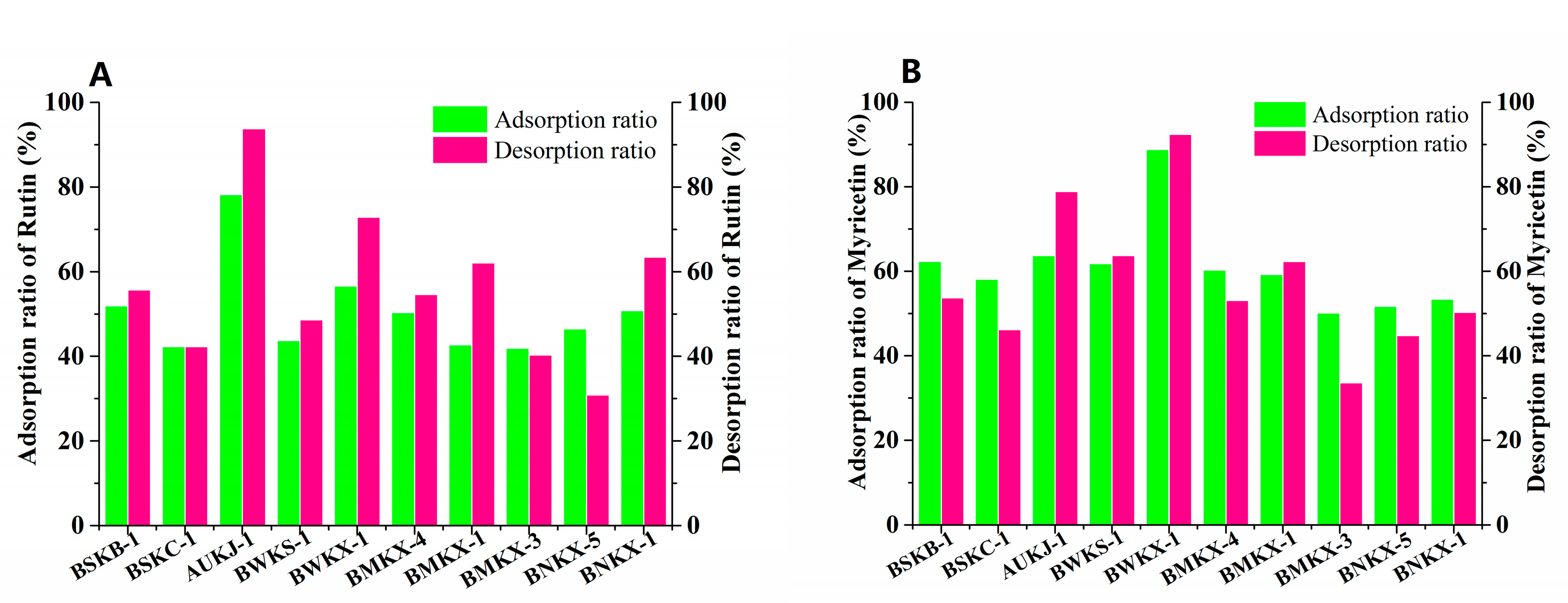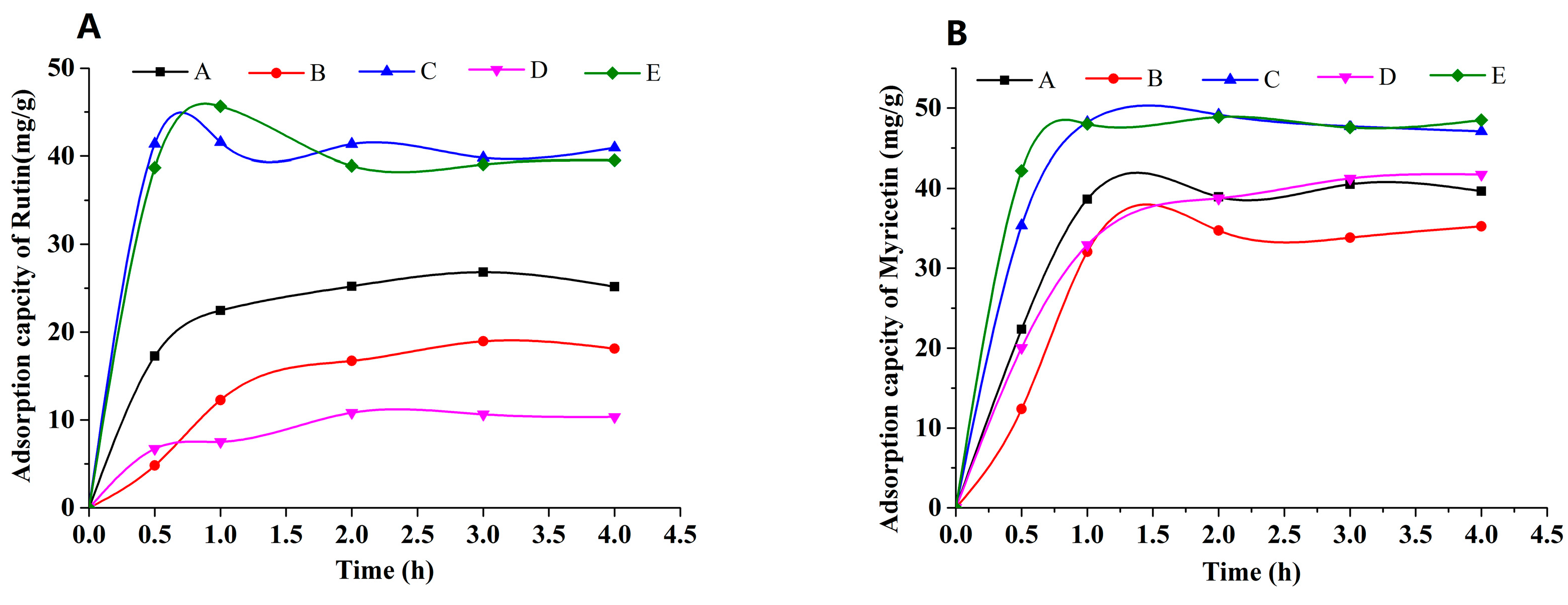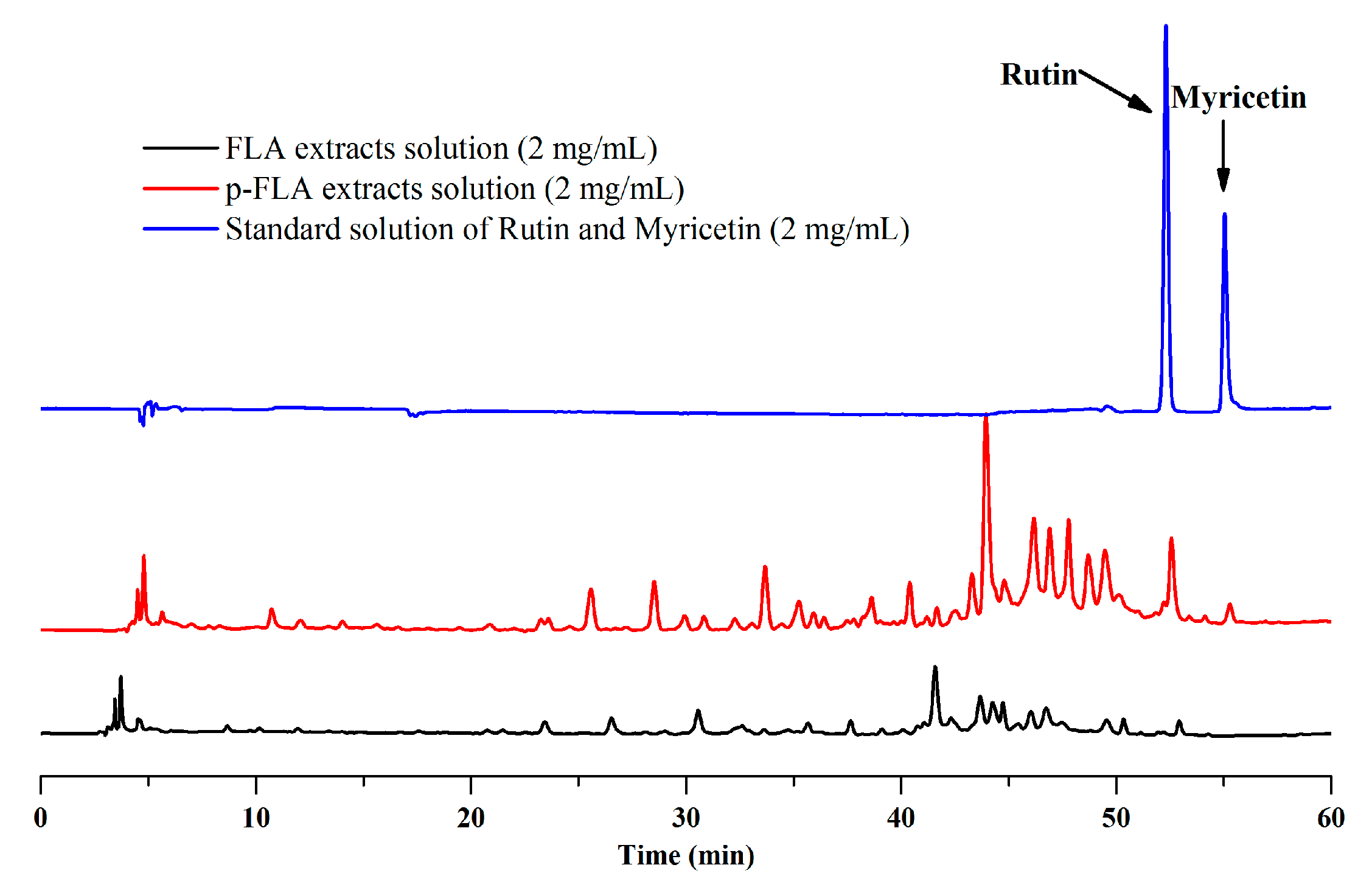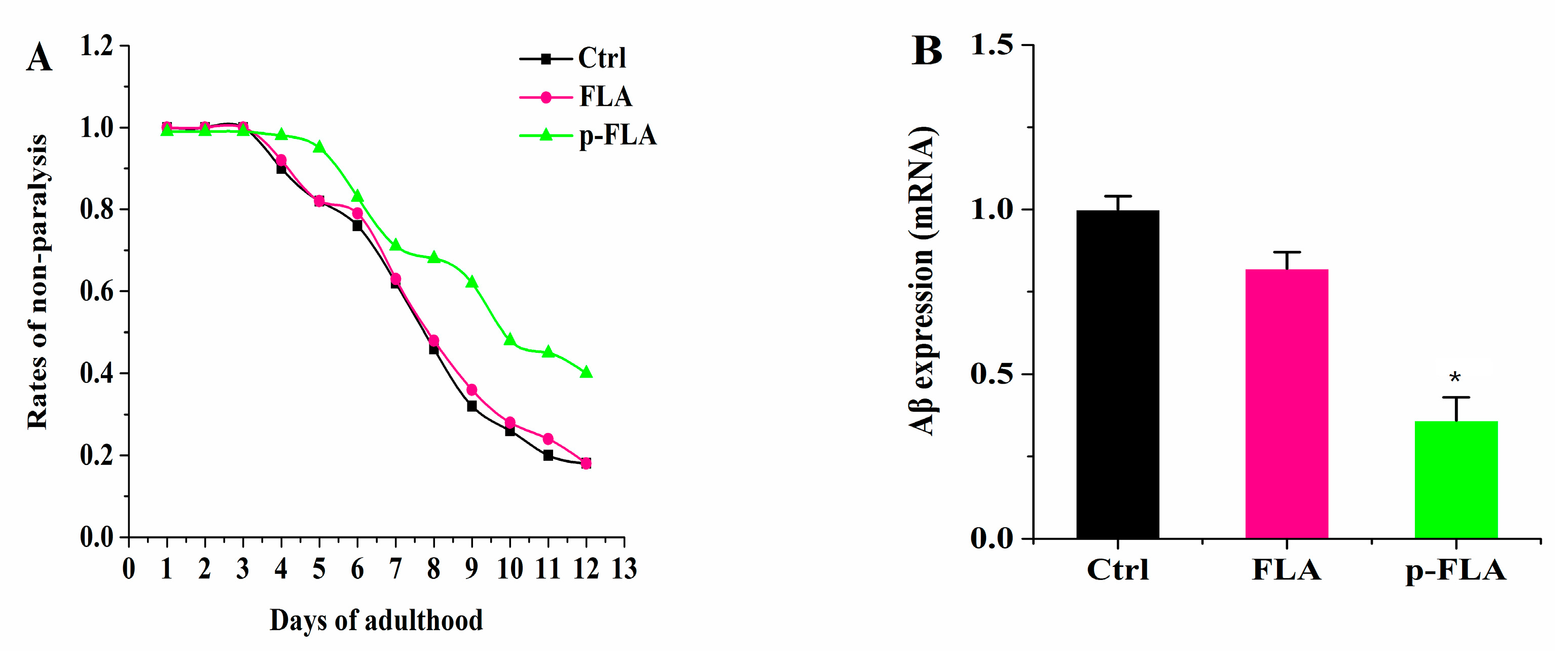Preparative Separation of Flavonoids from Goji Berries by Mixed-Mode Macroporous Adsorption Resins and Effect on Aβ-Expressing and Anti-Aging Genes
Abstract
:1. Introduction
2. Result and Discussion
2.1. Screening of Optimum Resin
2.2. Separation of FLAs by Mixed-Mode Macroporous Adsorption Resins
2.3. Adsorption/Desorption Kinetics on Mixed-Mode MARs
2.4. Dynamic Adsorption/Desorption on a Mixed-Mode MARs
2.4.1. Effect of Loading Concentration
2.4.2. Effect of Loading Rate
2.4.3. Effect of Ethanol Concentration
2.4.4. Effect of Elution Rate
2.5. Preparative Separation of FLAs from Goji Berries by Mixed-Mode MARs
2.6. Anti-Aging and Antioxidant Effect of FLA Extract and p-FLA Extract in C. elegans
2.7. Effect of FLA and p-FLA in Aβ-Expressing Nematode Model Strain CL2006
3. Materials and Methods
3.1. Chemical Reagents and Solvents
3.2. Apparatus
3.3. Preselection of MARs
3.4. Preparation of FLAs Solutions and Sample Solutions
3.5. HPLC-DAD Analysis of Rutin and Myricetin
3.6. Static Adsorption/Desorption Experiments
3.6.1. Static Adsorption/Desorption Experiments of Ten Resins
3.6.2. Static Adsorption/Desorption Experiments of Mixed-Mode Resin
3.7. Dynamic Adsorption/Desorption Experiments
3.8. Caenorhabditis elegans Strains and Treatment
3.9. Worm Synchronization and Paralysis Assay
3.10. Real-Time qPCR
4. Conclusions
Supplementary Materials
Author Contributions
Funding
Conflicts of Interest
References
- Jin, M.L.; Huang, Q.S.; Zhao, K.; Shang, P. Biological activities and potential health benefit effects of polysaccharides isolated from Lycium barbarum L. Int. J. Biol. Macromol. 2013, 54, 16–23. [Google Scholar] [CrossRef]
- Lu, W.Y.; Jiang, Q.Q.; Yu, L.L. Partial Least-Squares-Discriminant Analysis Differentiating Chinese Wolfberries by UPLC−MS and Flow Injection Mass Spectrometric (FIMS) Fingerprints. J. Agric. Food Chem. 2014, 62, 9073–9080. [Google Scholar] [CrossRef] [PubMed]
- Tian, X.J.; Liang, T.S.; Liu, Y.L.; Ding, G.T.; Zhang, F.M.; Ma, Z.R. Extraction, structural characterization, and biological functions of Lycium barbarum polysaccharides: A review. Biomolecules 2019, 9, 389. [Google Scholar] [CrossRef] [PubMed] [Green Version]
- Dong, J.Z.; Wang, S.H.; Zhu, L.Y.; Wang, Y. Analysis on the main active components of Lycium barbarum fruits and related environmental factors. J. Med. Plant Res. 2012, 6, 2276–2283. [Google Scholar]
- Zhou, Z.Q.; Fan, H.X.; He, R.R.; Xiao, J.; Tsoi, B.; Lan, K.H.; Kurihara, H.; So, K.F.; Yao, X.S.; Gao, H. Lycibarbarspermidines A-O, new dicaffeoylspermidine derivatives from wolfberry, with activities against Alzheimer’s disease and oxidation. J. Agric. Food Chem. 2016, 64, 2223–2237. [Google Scholar] [CrossRef]
- Gao, K.; Ma, D.W.; Cheng, Y.; Tian, X.R.; Lu, Y.Y.; Du, X.Y.; Tang, H.F.; Chen, J.Z. Three new dimers and two monomers of phenolic amides from the fruits of Lycium barbarum and their antioxidant activities. J. Agric. Food Chem. 2015, 63, 1067–1075. [Google Scholar] [CrossRef]
- Yao, X.; Peng, Y.; Xu, L.J.; Li, L.; Wu, Q.L.; Xiao, P.G. Phytochemical and biological studies of Lycium medicinal plants. Chem. Biodivers. 2011, 8, 976–1010. [Google Scholar] [CrossRef]
- Amagase, H.; Farnsworth, N.R. A review of botanical characteristics, phytochemistry, clinical relevance in efficacy and safety of Lycium barbarum fruit (Goji). Food Res. Int. 2011, 44, 1702–1717. [Google Scholar] [CrossRef]
- Li, X.L.; Zhou, A.G.; Li, X.M. Inhibition of Lycium barbarum polysaccharides and Ganoderma lucidum, polysaccharides against oxidative injury induced by γ-irradiation in rat liver mitochondria. Carbohydr. Polym. 2007, 69, 172–178. [Google Scholar] [CrossRef]
- Xiao, J.; Liong, E.C.; Ching, Y.P.; Chang, R.C.C.; So, K.H.; Fung, L.M.; Tipoe, G.L. Lycium barbarum polysaccharides protect mice liver from carbon tetrachloride-induced oxidative stress and necroinflammation. J. Ethnopharmacol. 2012, 139, 462–470. [Google Scholar] [CrossRef]
- Zheng, J.; Ding, C.; Wang, L.; Li, G.; Shi, J.; Li, H.; Wang, H.; Suo, Y. Anthocyanins composition and antioxidant activity of wild Lycium ruthenicum Murr. from Qinghai-Tibet Plateau. Food Chem. 2011, 126, 859–865. [Google Scholar] [CrossRef]
- Inbaraj, B.S.; Lu, H.; Kao, T.H. Simultaneous determination of phenolic acids and flavonoids in Lycium barbarum Linnaeus by HPLC–DAD–ESI-MS. J. Pharm. Biomed. Anal. 2010, 51, 549–556. [Google Scholar] [CrossRef] [PubMed]
- Zhou, Z.Q.; Xiao, J.; So, K.F.; Yao, X.S.; Gao, H. Polyphenols from wolfberry and their bioactivities. Food Chem. 2017, 214, 644–654. [Google Scholar] [CrossRef] [PubMed]
- Wu, S.; Wang, Y.; Gong, G.; Li, F.; Ren, H.; Liu, Y. Adsorption and desorption properties of macroporous resins for flavonoids from the extract of Chinese wolfberry (Lycium barbarum L.). Food Bioprod. Process. 2013, 93, 148–155. [Google Scholar] [CrossRef]
- Scordino, M.; Di Mauro, A.; Passerini, A.; Maccarone, E. Adsorption of flavonoids on resins: Cyanidin 3-glucoside. J. Agric. Food Chem. 2004, 52, 1965–1972. [Google Scholar] [CrossRef]
- Lin, L.; Zhao, H.; Dong, Y.; Yang, B.; Zhao, M. Macroporous resin purification behavior of phenolics and rosmarinic acid from Rabdosia Serra (MAXIM.) HARA leaf. Food Chem. 2012, 130, 417–424. [Google Scholar] [CrossRef]
- Kammerer, D.R.; Carle, R.; Stanley, R.A.; Saleh, Z.S. Pilot-scale resin adsorption as a means to recover and fractionate apple polyphenols. J. Agric. Food Chem. 2010, 58, 6787–6796. [Google Scholar] [CrossRef]
- Chang, X.L.; Wang, D.; Chen, B.Y.; Feng, Y.M.; Wen, S.H.; Zhan, P.Y. Adsorption and desorption properties of macroporous resins for anthocyanins from the calyx extract of roselle (Hibiscus sabdariffa L.). J. Agric. Food Chem. 2012, 60, 2368–2376. [Google Scholar] [CrossRef]
- Che Zain, M.S.; Lee, S.Y.; Teo, C.Y.; Shaari, K. Adsorption and Desorption Properties of Total Flavonoids from Oil Palm (Elaeis guineensis Jacq.) Mature Leaf on Macroporous Adsorption Resins. Molecules 2020, 25, 778. [Google Scholar] [CrossRef] [Green Version]
- Xiao, J.; Pan, Y.; Zhang, L.; Wang, X.; Han, Y.; Sun, L. High performance liquid chromatography determination and optimization of the extraction process for the total alkaloids from traditional herb stephania cepharantha hayata. Molecules 2019, 24, 388. [Google Scholar] [CrossRef] [Green Version]
- Lou, S.; Chen, Z.B.; Liu, Y.F.; Ye, H.L.; Di, D.L. Synthesis of functional adsorption resin and its adsorption properties in purification of flavonoids from Hippophae rhamnoides L. Leaves. Ind. Eng. Chem. Res. 2012, 51, 2682–2696. [Google Scholar] [CrossRef]
- Lou, S.; Di, D.L. Adsorption features of flavonoids on macroporous adsorption resins functionalized with ionic liquids. Chem. Phys. Chem. 2015, 16, 1329. [Google Scholar] [CrossRef] [PubMed]
- Lou, S.; Chen, Z.B.; Liu, Y.F.; Ye, H.L.; Di, D.L. New way to analyze the adsorption behavior of flavonoids on macroporous adsorption resins functionalized with chloromethyl and amino groups. Langmuir 2011, 27, 9314–9326. [Google Scholar]
- Liu, Y.; Li, X.T.; Huang, D.D.; Di, D.L. Comparison of adsorption selectivity for (–)-epigallocatechin gallate and caffeine by porous materials modified with different amino groups. Colloids Surf. A Physicochem. Eng. Asp. 2017, 520, 166–172. [Google Scholar] [CrossRef]
- Li, X.T.; Liu, Y.; Di, D.L.; Wang, G.H.; Liu, Y.F. A formaldehyde carbonyl groups-modified self-crosslinked polystyrene resin: Synthesis, adsorption and separation properties. Colloids Surf. A Physicochem. Eng. Asp. 2016, 500, 1–9. [Google Scholar] [CrossRef]
- Liu, Y.F.; Liu, J.X.; Chen, X.F.; Di, D.L. Preparative separation and purification of lycopene from tomato skins extracts by macroporous adsorption resins. Food Chem. 2010, 123, 1027–1034. [Google Scholar] [CrossRef]
- Liu, Y.F.; Bai, Q.Q.; Lou, S.; Di, D.L.; Li, J.T.; Guo, M. Adsorption characteristics of (-)-epigallocatechin gallate and caffeine in the extract of waste tea on macroporous adsorption resins functionalized with chloromethyl, amino, and phenylamino groups. J. Agric. Food Chem. 2012, 60, 1555–1566. [Google Scholar] [CrossRef]
- Li, J.; Chen, Z.B.; Di, D.L. Preparative separation and purification of rebaudioside a from Stevia rebaudiana Bertoni crude extracts by mixed bed of macroporous adsorption resins. Food Chem. 2012, 132, 268–276. [Google Scholar]
- Liu, Y.F.; Di, D.L.; Bai, Q.Q.; Chen, Z.B.; Lou, S. Preparative separation and purification of rebaudioside a from steviol glycosides using Mixed-Mode macroporous adsorption resins. J. Agric. Food Chem. 2011, 59, 9629–9636. [Google Scholar] [CrossRef]
- Huang, J.H.; Yan, C.; Huang, K.L. Removal of p-nitrophenol by a water-compatible hypercrosslinked resin functionalized with formaldehyde carbonyl groups and XAD-4 in aqueous solution: A comparative study. J. Colloid Interf. Sci. 2009, 332, 60–64. [Google Scholar] [CrossRef]
- Xiao, G.Q.; Wen, R.M.; Wei, D.M.; Wu, D. Effects of the steric hindrance of micropores in the hyper-cross-linked polymeric adsorbent on the adsorption of p-nitroaniline in aqueous solution. J. Hazard. Mater. 2004, 280, 97–103. [Google Scholar] [CrossRef] [PubMed]
- Chen, Z.B.; Zhang, A.J.; Li, J.; Dong, F.; Di, D.L.; Wu, Y.Z. Study on the adsorption feature of rutin aqueous solution on macroporous adsorption resins. J. Phys. Chem. B 2010, 114, 4841–4853. [Google Scholar] [CrossRef] [PubMed]
- Wang, H.; Liu, R.R.; Liu, Y.F.; Di, D.L. Investigation on adsorption mechanism of peptides with surface-modified super macroporous resins. Langmuir 2019, 35, 4471–4480. [Google Scholar] [CrossRef] [PubMed]
Sample Availability: Samples of the compounds are available from the authors. |







© 2020 by the authors. Licensee MDPI, Basel, Switzerland. This article is an open access article distributed under the terms and conditions of the Creative Commons Attribution (CC BY) license (http://creativecommons.org/licenses/by/4.0/).
Share and Cite
Liu, J.; Meng, J.; Du, J.; Liu, X.; Pu, Q.; Di, D.; Chen, C. Preparative Separation of Flavonoids from Goji Berries by Mixed-Mode Macroporous Adsorption Resins and Effect on Aβ-Expressing and Anti-Aging Genes. Molecules 2020, 25, 3511. https://doi.org/10.3390/molecules25153511
Liu J, Meng J, Du J, Liu X, Pu Q, Di D, Chen C. Preparative Separation of Flavonoids from Goji Berries by Mixed-Mode Macroporous Adsorption Resins and Effect on Aβ-Expressing and Anti-Aging Genes. Molecules. 2020; 25(15):3511. https://doi.org/10.3390/molecules25153511
Chicago/Turabian StyleLiu, Jianfei, Jiao Meng, Jinhao Du, Xiaofeng Liu, Qiaosheng Pu, Duolong Di, and Chang Chen. 2020. "Preparative Separation of Flavonoids from Goji Berries by Mixed-Mode Macroporous Adsorption Resins and Effect on Aβ-Expressing and Anti-Aging Genes" Molecules 25, no. 15: 3511. https://doi.org/10.3390/molecules25153511
APA StyleLiu, J., Meng, J., Du, J., Liu, X., Pu, Q., Di, D., & Chen, C. (2020). Preparative Separation of Flavonoids from Goji Berries by Mixed-Mode Macroporous Adsorption Resins and Effect on Aβ-Expressing and Anti-Aging Genes. Molecules, 25(15), 3511. https://doi.org/10.3390/molecules25153511





